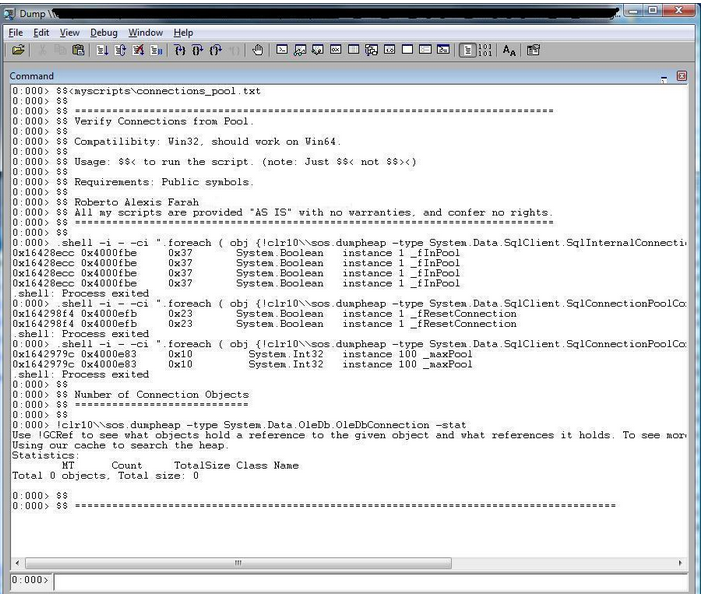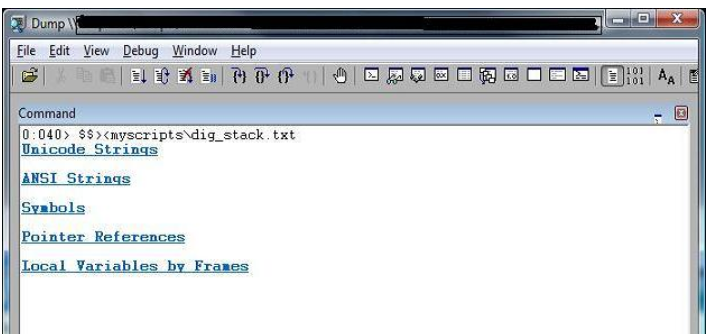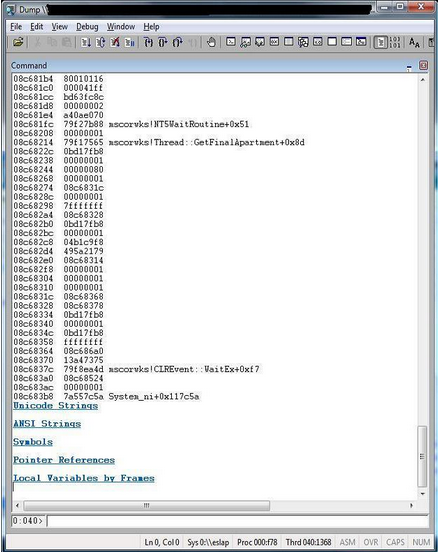在过去,我研究了一个支持案例,我需要找出C++应用程序中的一些消息框是否被显示,如果是肯定的,消息是什么。每次我问用户时得到的回答都不一致,所以我不知道是否出现了MessageBox或消息是什么。
这听起来像是另一个完美的场景,脚本可能会有所帮助!事实上,这对我帮助很大,我希望对你也有帮助。这个脚本映射MessageBox调用,并将消息从MessageBox记录到Windbg屏幕上,也记录到一个文本文件中。
调试应用程序后,应使用“.logclose”关闭日志。然后您可以搜索字符串“Text from MessageBox”,您将得到应用程序显示的所有MessageBox!
你可以用DBMon.exe或者DebugView.exe查看来自MessageBox窗口的消息。我从来没有在.NET应用程序上测试过它,但它应该可以工作,因为MessageBox是在一些.NET Framework调用的幕后调用。
截图如下:

注意!在上面的命令后按两次回车键而不是一次。


Source code for MSGBOX_TRACING.TXT:
$$
$$ =============================================================================
$$ Log MessageBox messages in a log file.
$$ The log file name starts with MessageBox string.
$$
$$ Compatibility: Win32.
$$
$$ Usage: $$>< to run the script.
$$
$$ Requirements: Public symbols.
$$
$$ Roberto Alexis Farah
$$ Blog: http://blogs.msdn.com/debuggingtoolbox/
$$
$$ All my scripts are provided "AS IS" with no warranties, and confer no rights.
$$ =============================================================================
$$
$$ This location 7EEEEEEE is difficult to be used but
$$ it could be occupied!!!
$$
.dvalloc /b 0x7EEEEEEE 0x400
r @$t0 = 0x7EEEEEEE
eb 0x7EEEEEEE 50
bp user32!MessageBoxExW "r @$t1 = @eip; r @eax = poi(@esp + 0x8); r @eip = @$t0;g"
bp @$t0 + 0x6 ".echo <-- Text from MessageBox; r @$ip = @$t1;g"
.logopen /t /u MessageBox.txt
.printf /D "\nType <b>call kernel32!OutputDebugStringW</b> then press Enter key two times then 'g' command after it.\n"
a 0x7EEEEEEF
$$
$$ ATTENTION! Use .logclose after finishing the debugging session.
$$
$$ =========================
Note: Some of my previous scripts were updated! Whenever I do that I write a small comment about it explaining the update.
- « 前一页
- 1
- ...
- 1575
- 1576
- 1577
- 1578
- 1579
- 1580
- 1581
- ...
- 1644
- 后一页 »






